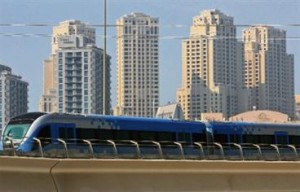By Parag Deulgaonkar www.business34-7.ae
Residential and commercial properties in the immediate vicinity of the Metro stations could see a potential uplift of 10 to 20 per cent, an international real estate advisory firm said yesterday.

“If the Metro proves popular and efficient then it is very likely we will see a significant impact on the values around stations. The early signs have been positive. We consider the potential uplift in the immediate vicinity of the Metro stations, that is less than 400 metres, could be in the region of 10 to 20 per cent for both residential and commercial uses, but this impact will not be even across the station network,” said Andrew Edwards, Associate Director at DTZ in a report on the impact of the Dubai Metro on real estate values.
Reports earlier indicated that property prices close to the Metro could see a marginal increase of five per cent.
Prices in the central business district (CBD) are likely to increase less than locations at the fringe of a city. This is because prices are often higher and accessibility is normally already good in the CBD.
“In short, there is a greater impact where current accessibility is poor. Different communities experience property value benefits differently. Value is imparted where the local population values the additional access provided by the Metro regardless of the income of the district. In some examples, this has translated into high income areas achieving minimal value uplift as the car is still the preferred mode of transport,” said DTZ.
However, the advisory firm said it is too early to tell at this stage what the full impact of the new Metro in Dubai will have on land and property values around stations.
“Developers and landowners are engaging with the RTA to improve connections to the Metro in the belief that it will improve the attractiveness of adjacent land. There was a limited “announcement effect” (an uplift in values immediately following the public announcement of the scheme) of the Dubai Metro on land prices as the concept of mass public transport was not familiar or proven in the emirate. This, coupled with the downturn in the property cycle, has prevented the ‘pre-opening’ impacts from being particularly significant.”
The “opening effect” is yet to be quantified and it has been diluted by the fact that only 10 of the stations on the Red Line opened on September 9.
International experience, according to the report, suggests the market may overreact prior to the opening so values may actually fall in the short term.
“However, we do not consider that this will be the case in Dubai due to the recent wider market correction. Studies indicate that there could be a significant time lag involved in the ‘capitalisation of transport improvements’ (impact on value) of up to three to five years.”
The impact is also likely to be more significant at certain destinations such as Jumeirah Lake Towers (JLT) for residential and Dubai International Financial Centre (DIFC) for commercial. This is because there is a high concentration of residential use at JLT and commercial use at DIFC, which is likely to translate into a high level of trip generation.
One consideration that will impact on any rental rise is the view of the Real Estate Regulatory Agency (Rera), which currently does not factor in Metro stations in its rental price index. The rental levels will therefore still have to remain within the range defined by the agency. However, new properties to the market will obtain the full benefit, as Rera does not cover the first letting, said DTZ.
The image the Metro portrays of Dubai should not be underestimated either as it represents the first and only urban transport system in the GCC. DTZ considers this will have a “positive” impact, attracting inward investment and globally mobile occupiers.
“As a general rule, the larger the modal share [the percentage of people using the Metro in relation to other forms of transport], the larger the impact on surrounding values. Early signs have been positive,” said the report.
Catchment areas
In terms of catchment areas, evidence suggests that impacts on land values and property prices will be experienced up to 400 metres from the station for commercial properties and a longer distance of 800-1,000 metres for residential property.
This catchment area relates to the distances people are prepared to walk. This usually translates to five to 10 minutes for commercial buildings and 10-20 minutes for residential. Therefore the catchment areas are wider for residential than commercial, but in the case of Dubai, the acceptable walking distances will be at the lower end of the spectrum because of the prevailing weather conditions.
In Dubai, acceptable walking distances will vary greatly depending on whether there is a walkway and it is covered and air conditioned (a pedway) or open to the elements. This suggests that proactive action can be taken to extend the catchment area by providing covered walkways.
Metro effect
It is very difficult to isolate the “Metro effect” because property markets are not heterogeneous and localised factors will impact on values, said DTZ.
Rail infrastructure is thought to have played a direct role in increasing the density of development in many cities and can also impact on the form of development.
The greatest uplift tends to be seen in compact cities with dominant centres. Cities that have a strong downtown and/or having dispersed trip patterns, may not take full advantage of the high capacity potential of metro systems.
A key factor appears to be the extent to which transit systems are well developed.
Accessibility key to demand
The value uplift depends on how far the property is from the transit hub and the availability of other transport options. Therefore, accessibility is a key element in determining residential and commercial price value change.
The higher the usage rates of the Metro, the higher the value uplifts. This reinforces the notion that transit accessibility is the strongest determinant of property value uplift. “The evidence base suggests in the majority of cases the extent of value uplift is significant. There may, however, be some loss of value immediately around stations, particularly for residential, due to environmental factors such as noise levels, increased vibration, increased car traffic and visual intrusion,” DTZ said.


















